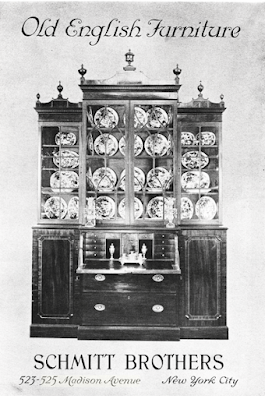photo by the author
Gramercy Park, ringed with elegant mansions, proved a good location for Schmitt Brothers to open a fine antiques business in 1852. The imported European and English furniture and accessories it sold were sought by the wealthy residences of the district. As the decades passed, the firm's patrons purchased not only its 17th and 18th century furniture, but marble statues, mirrors, silver and plate, and, for some millionaires, entire rooms dismantled from grand European homes.
As its clients moved northward, the firm followed. At the end of World War I, Schmitt Brothers was located at 343-345 Madison Avenue. And another move was on the near horizon. In 1919 Schmitt Brothers, Inc. purchased the two five-story brownstones at 523 and 525 Madison Avenue with intentions, according to the Furniture Index, of altering to its new showrooms.
Trouble ensued before alterations began. The Visiting Nurses of Somerset Hills approached Schmitt Brothers, and asked if it could use the vacant house at 523 Madison Avenue as the site of a benefit rummage sale. Court papers would later say that Schmitt Brothers "granted this permission rent free, upon condition that a letter be written it relieving it from any liability."
The condition proved to be a prescient move. On March 10, 1920, the morning of the sale, several well dressed women climbed the stoop to attend the event. Suddenly the entire stoop railing on the right side gave way and several of the women plummeted to the the stone areaway below, injuring one rather seriously. The incident ended up in court, and although the woman was initially awarded $1,250 in damages, an appeals court later reversed the decision.
Two days after the incident, the architectural firm of Schwartz & Gross filed plans to alter the two brownstones at 523 and 525 Madison Avenue at a cost of $50,000--about $645,000 in today's money. The renovations would take only six months to complete, but the results were stunning.
Schwartz & Gross had produced a stately, five-story neo-Colonial structure based on a Georgian domestic mansion design. Clad in rough red brick with limestone trim, the architects used burned header bricks to give the illusion of age. A prominent fanlight under an arched hood and leaded transom added to the 18th century feeling of the paneled double doors. Stone bandcourses defined each story, and simple keystones graced each of the upper openings. A triangular brick pediment, outlined in modillioned cornices, sat before the copper-clad mansard roof.
In preparation for its move, Schmitt Brothers, Inc. held an "extraordinary sale by auction" on September 22 and 23. The "extensive collection," according to the sale notice, included:
English, French and Italian Antiques of the 17th and 18th Century, together with its well known stock of Modern Furniture and many reproductions of the Highest Type, Mirros, Objects of Art, Sheffield Plate, Terra Cottas and Marbles, Etc., Etc.
The firm opened in its new headquarters on October 1, 1920. Several years earlier, the Fifth Avenue Association had initiated an annual awards competition for new and altered buildings. On November 20, 1902 the New-York Tribune reported on the previous evening's awards dinner, at which "coveted medals and diplomas" were presented. The article noted that, 'The buildings were considered from the standpoint of the tenant, the standpoint of the builders and the standpoint of the architecture." Taking second place in the altered building class was "Schmitt Brothers' interesting business headquarters at 525 Madison Avenue."
After slightly more than a quarter of a century in their building, in 1947 Schmitt Brothers, Inc. announced it would move to 17 East 54th Street. The Madison Avenue building was renovated that year to showrooms throughout.
By 1974 it was home to Merns menshops. The New York Times that year described it as "specializing in high-style suits, American and European labels." The shop's customers were up-and-coming businessmen rather than more affluent executives. Three-piece suits could be purchased that year for $99--around $520 today.
By 1985 the store name had been changed to MernsMart, which unapologetically marketed itself as a discount clothing store. A pin stripe, single-breasted suit, for instance, "sold elsewhere for $325" was priced at $199.99 in May 1985.
A renovation was begun in 1990 for a Talbots women's clothing store. The store space now engulfed the three lower floors, while offices occupied the upper floors. It was most likely at this time that the paneled shutters were added to the windows.
Talbots's first store was opened in 1947 in Massachusetts and became a household name the following year when it branched into direct mail order. This store remained at 523-525 Madison Avenue until 2000.
Although Schwartz & Gross's storefront and entrance have been severely altered, their prize-winning Colonial structure is otherwise little changed, a surprising presence in the bustling Madison Avenue neighborhood.
no permission to reuse the content of this blog has been granted to LaptrinhX.com




.png)
I believe Talbot’s was at this address long past 2000, as I shopped there in 2014.
ReplyDelete